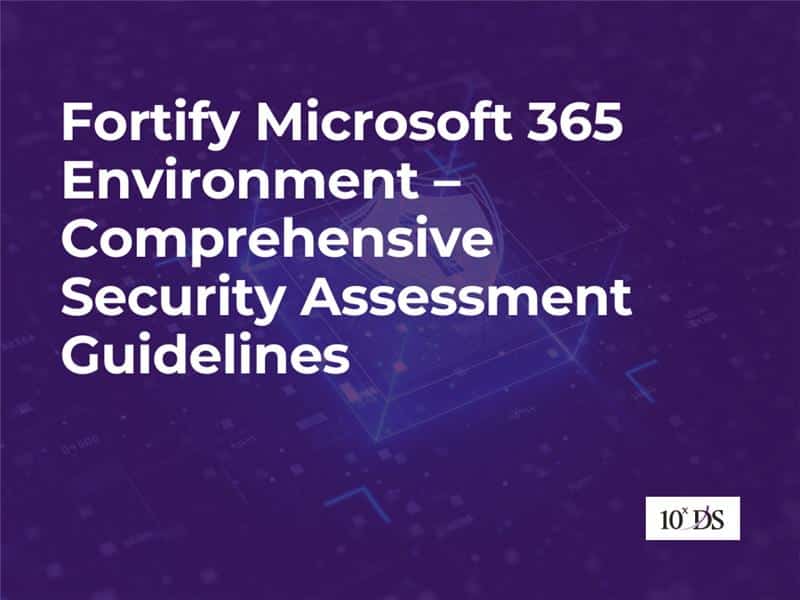
Fortify Microsoft 365 Environment – Comprehensive Security Assessment Guidelines
In today’s digital landscape, Microsoft 365 (M365) stands as a cornerstone for many organizations, facilitating seamless collaboration and productivity. However, as reliance on M365 grows, so does the importance of ensuring its security against evolving cyber threats.M365’s expansive suite of tools and services makes it a prime target for cyberattacks. Organizations face risks such as:
- Data Breaches: Unauthorized access can compromise sensitive information.
- Compliance Penalties: Non-adherence to regulatory standards can result in hefty fines.
- Operational Disruptions: Security incidents can lead to significant downtime, affecting business continuity.
Given these scenarios, a proactive approach to M365 security is not just advisable—it’s essential.
Challenges in Managing M365 Security
While Microsoft provides a robust suite of built-in security tools and features, effectively managing and securing the entire M365 ecosystem is far from straightforward. Many businesses face significant hurdles in achieving a secure, compliant, and well-optimized M365 environment. Below are some of the most common and pressing challenges organizations encounter in managing Microsoft 365 security.
- Complex Configurations: Microsoft 365 is a powerful suite packed with a wide array of services, including Exchange Online, SharePoint, Teams, Entra ID (formerly Azure AD), and more. Each of these services comes with its own set of configuration options, security settings, and access controls. The sheer complexity and interconnectedness of these tools make it easy for misconfigurations to occur—often unintentionally—leading to potential security gaps. For example, incorrect sharing permissions in SharePoint or overly permissive mailbox access can expose sensitive information to unauthorized users. To fully secure an M365 environment, organizations must have a deep understanding of how these services interact and ensure every setting aligns with best practices, which can be an overwhelming task without specialized knowledge and tools.
- Compliance Demands: In today’s regulatory landscape, organizations must adhere to stringent standards set by frameworks such as the Cybersecurity and Infrastructure Security Agency (CISA), GDPR, HIPAA, and others. These standards often require specific configurations, audit logging, data protection measures, and ongoing monitoring—all of which must be consistently enforced across the entire M365 ecosystem. Staying compliant isn’t a one-time setup; it’s an ongoing process that demands regular reviews, updates, and reporting. Without a systematic and proactive compliance strategy, businesses risk falling short of these requirements, leading to penalties, legal consequences, and reputational damage. Navigating these complex compliance obligations within the M365 environment can be daunting for IT teams already stretched thin.
- Limited Expertise: While many organizations have embraced Microsoft 365 for its productivity benefits, not all have the in-house expertise to manage and secure it effectively. Security in M365 goes beyond simple user account management—it involves implementing advanced threat protection, managing device access policies, configuring conditional access, conducting security audits, and understanding threat analytics. These tasks require specialized knowledge of both the platform and modern cybersecurity practices. Smaller IT teams or businesses without dedicated security professionals may struggle to stay ahead of evolving threats, increasing their vulnerability. This skills gap makes it critical for organizations to seek external guidance or assessments to identify weaknesses and strengthen their M365 security posture.
Common Flaws Found Only Through Proper Microsoft 365 security assessment
Simply adopting Microsoft 365 isn’t enough to guarantee protection. Many organizations assume that default settings or one-time configurations are sufficient, when in reality, critical vulnerabilities can remain hidden beneath the surface. These flaws often go undetected in daily operations and can only be uncovered through a thorough, structured security assessment. Below are some of the most common—and often surprising—issues that are typically discovered during a detailed Microsoft 365 security review.
1. Incomplete MFA Coverage
One of the most common and critical oversights is the inconsistent use of Multi-Factor Authentication (MFA). While it’s often enabled for some users, many organizations fail to enforce it for all accounts—especially privileged, service, or executive accounts—leaving major vulnerabilities. These gaps typically go undetected without a structured security review.
2. Excessive Admin Privileges
Organizations frequently assign Global Admin roles far more liberally than needed. Multiple users often have elevated privileges without valid justification, which greatly increases the attack surface. In the event of a breach, compromised admin accounts can give attackers unrestricted access to the environment.
3. Misconfigured Conditional Access Policies
Even when Conditional Access is set up, it’s often too permissive or inconsistently applied. Many configurations allow access from unmanaged devices, legacy authentication protocols, or untrusted locations—risk scenarios that are rarely spotted without a detailed configuration assessment.
4. Risky External Sharing Practices
SharePoint, OneDrive, and Teams are commonly used for external collaboration, but organizations often don’t monitor or review what’s being shared. Files may be accessible via public links or to former collaborators whose access was never revoked—posing significant data leakage risks that only emerge in a full audit.
5. Orphaned or Dormant Accounts
It’s not uncommon to discover active accounts for employees who have left the organization or for temporary users who were never offboarded. These accounts—especially if privileged—are low-hanging fruit for attackers, and often remain under the radar without a proper identity review.
6. Unreviewed Third-Party App Access
OAuth-based apps and integrations often gain access to read emails, files, or calendars. Many of these apps are connected without IT approval and can introduce backdoors into the environment. These are rarely discovered unless specific tools and reviews are used during an assessment.
7. Audit Logging Not Enabled
Shockingly, many organizations have not enabled Microsoft’s Unified Audit Log, which is essential for tracking user behavior, changes, and potential security incidents. Without it, organizations lack the visibility to detect or investigate threats—making breaches harder to catch or contain.
8. Underutilized Microsoft Defender Features
Although many companies invest in Microsoft Defender for Office 365, its advanced capabilities are often left unconfigured. Features like Safe Links, Safe Attachments, threat alerts, and automated investigations may be partially implemented or entirely inactive—greatly reducing security effectiveness.
9. Lack of Data Protection Policies
A surprising number of tenants lack properly implemented Data Loss Prevention (DLP) policies, classification rules, or encryption standards. Sensitive data is often unmonitored and unprotected, relying on manual controls that don’t scale—leaving the door open to accidental or intentional data exposure.
10. Shadow IT and Unmanaged Access
Without visibility tools, many organizations are unaware of shadow IT activity—such as unsanctioned apps or devices accessing Microsoft 365. These unmanaged endpoints pose a major threat and typically come to light only through advanced monitoring during a formal assessment.
11. No Incident Response Preparedness
Even with alerts in place, many businesses don’t have a defined incident response plan. There’s no clarity on who’s responsible for handling a breach, how to escalate issues, or how to respond in real time. A thorough assessment will reveal these process gaps and recommend a response framework
Comprehensive M365 Security Assessment – How Is It Done?
A comprehensive Microsoft 365 Security Assessment is a structured process designed to evaluate the security posture of your M365 environment, identify vulnerabilities, and provide actionable insights to strengthen defenses.
1. Assessment Setup and Planning
The first step involves detailed discussions with your organization to define the scope of the assessment. This includes identifying which M365 services and components—like Entra ID (formerly Azure AD), Microsoft Defender, Microsoft Purview, Exchange Online, SharePoint, and Teams—will be reviewed.
2. Tool Deployment and Data Collection
Specialized security tools and scripts are deployed within your environment to extract current configuration data securely. These tools analyze various aspects, such as identity and access management, data loss prevention settings, email security, endpoint protection, audit logs, and compliance controls. The collected data forms the foundation for an in-depth analysis of your current security setup.
3. Security Analysis and Benchmarking
The gathered information is then assessed against industry benchmarks—particularly CISA’s Microsoft 365 Secure Configuration Baselines. These baselines represent the gold standard for secure configuration and help identify any gaps, misconfigurations, or policy weaknesses in your existing setup. This phase also evaluates how well your environment aligns with best practices for identity protection, threat detection, and zero-trust architecture.
4. Detailed Reporting and Risk Visualization
Compiling the findings into a comprehensive security assessment report will help for further remediation. This report includes:
- A summary of critical risks and vulnerabilities
- A scorecard showing your security maturity across key areas
- Compliance gaps related to standards like CISA, GDPR, or HIPAA
- Prioritized recommendations with actionable next steps
The report is designed to be both technically thorough and executive-friendly, ensuring all stakeholders understand the risk landscape and the required improvements.
5. Continuous Security Advisory
For organizations looking for ongoing oversight, periodic health checks is needed to maintain optimal M365 security and stay ahead of emerging threats.
As cyber threats continue to evolve, securing your Microsoft 365 environment is no longer optional—it’s a strategic necessity. A comprehensive security assessment not only uncovers hidden vulnerabilities and misconfigurations but also provides the clarity and direction needed to build a stronger, more resilient digital workspace. By aligning with industry best practices and leveraging expert insights, organizations can move beyond reactive security and establish a proactive, compliance-ready foundation. Investing in a proper Microsoft 365 security assessment today means safeguarding your data, your users, and your business continuity for the future.
Check our M365 assessment page for more info.


